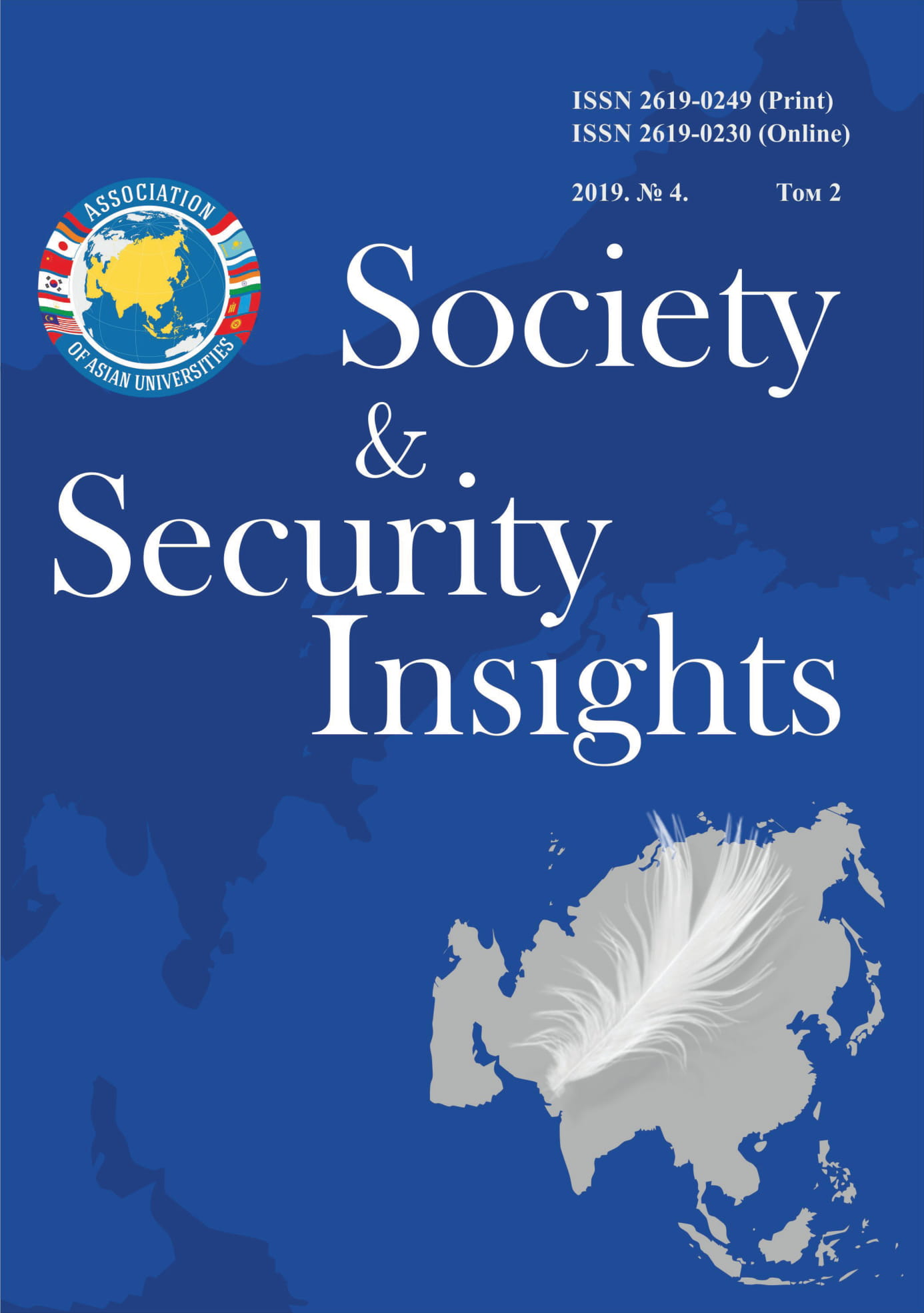БЕЗОПАСНОСТЬ МИГРАНТОВ И НАСЕЛЕНИЯ ПРИНИМАЮЩЕЙ ТЕРРИТОРИИ В ОЦЕНКАХ ЖИТЕЛЕЙ АЛТАЙСКОГО КРАЯ
Основное содержание статьи
Аннотация
В статье использованы данные, полученные в рамках исследования особенностей проявления доверия и оценок социальной безопасности населения Алтайского края (2019, n = 621) в возрасте от 15 до 75 лет, на основе выделения в общей выборке населения региона подвыборки коренного и диаспорального сообщества, имеющего опыт транзитных перемещений. Получены как оценки личной безопасности перемещающегося населения, так и оценки безопасности регионального социума, принимающего иностранных мигрантов. Большинство респондентов, сами являясь мигрантами, не так давно принятыми в региональном сообществе, отрицательно относятся к мигрантам. Видимо, являясь гражданами России, адаптировавшись в принимающем сообществе, транзитные мигранты становятся на иные, близкие к аборигенному «стационарному» населению позиции. При этом усиливает негативное отношение к мигрантам осознание не исходящей от них угрозы, а, наоборот, ее отсутствие. В представлениях населения ощущение безопасности связано в первую очередь с присутствием мигрантов в российском приграничье, далее имеет значение распространенность негативных социальных стереотипов о миграции и мигрантах, усиливает опасность и низкий социально-экономический статус региона проживания.
Скачивания
Metrics
Детали статьи

Это произведение доступно по лицензии Creative Commons «Attribution-NonCommercial-NoDerivatives» («Атрибуция — Некоммерческое использование — Без производных произведений») 4.0 Всемирная.
Authors retain the copyright of their manuscripts, and all Open Access articles are distributed under the terms of the Creative Commons Attribution License, which permits unrestricted use, distribution, and reproduction in any medium, provided that the original work is properly cited.
Литература
Adams R. H., A. Cuecueccha & J. Page. Remittances, Consumption and Investment in Ghana. Policy Research Working Paper, 2008, 4515.
Azam J. P. & Gubert F. Migrants’ Remittances and the Household in Africa: A Review of the Evidence. Journal of African Economies, 2006. 15(2), 426-462.
Chami R. Remittances and Institutions: Are Remittances a Curse? IMF Working Paper WP/08/29. 2008.
Docquier F., Rapoport H., & Shen. I-L. Remittances and Inequality: A Dynamic Migration Model. Journal of Economic Inequality, 2010. 8(2), 197-220.
Giuliano P., & Ruiz-Arranz M. Remittances, Financial Development and Growth. IMF Working Paper Series, WP/05/234. 2005.
Gott C., & Johnston K. The migrant population in the UK: Fiscal effects. The Research, Development and Statistics Directorate Occasional Paper no. 77, Home Office. 2002.
Gupta S., Pattillo C., & Wagh S. Impact of Remittances on Poverty and Financial Development in Sub-Saharan Africa. IMF Working Paper, WP-07-38, IMF. 2007.
IMF (International Monetary Fund). Implementation of the Joint Management Action Plan on Bank-Fund Collaboration. International Monetary Fund and World Bank. 2010. Retrieved from http://www.imf.org/external/np/pp/eng/2010/030310.pdf.
Kremer M. & Watt S. The Globalization of Household Production. Working Paper 2008-0086, Weatherhead Center for International Affairs, Harvard University. 2006.
Maximova S., Omelchenko D.A., Noyanzina O.E. Social Risks and Vulnerability of Labor Migrants in the Russian Borderland. The European Proceedings of Social & Behavioural Sciences EpSBS. 73-80. doi:10.15405/epsbs.2019.04.02.10. 2019.
Maximova S.G., Morkovkina A.G., Omelchenko D.A., Noyanzina O.E., Maximova M.M. Gender peculiarities of the attitude of Russians to migration // Procedia — 4th EER International Conference on Social Sciences and Interdisciplinary Studies, August 18-20, 2018. Palermo, Sicily, Italy.
Toxopeus H., & Lensink R. Remittances and Financial Inclusion in Development. UNU-WIDER Research Paper, 2007/49, Helsinki. 2017.
UNDP (United Nations Development Program). Overcoming Barriers: Human Mobility and Development. United Nations Development Program, New York. 2019.
World Bank. Global Economic Prospects 2006: Economic Implications of Remittances and Migration. World Bank, Washington DC. 2006.
Yang D. & Choi H. Are Remittances Insurance? Evidence from Rainfall Shocks in the Philippines. The World Bank Economic Review, 2007. 21(2), 219-248.
References
Adams, R. H. (2005). Do International Migration and Remittances Reduce Poverty in Developing Countries? World Development, 33(10), 1645-1669.
Adams, R. H., A. Cuecueccha, & J. Page (2008). Remittances, Consumption and Investment in Ghana. Policy Research Working Paper, 4515.
Azam, J. P., & Gubert F. (2006). Migrants’ Remittances and the Household in Africa: A Review of the Evidence. Journal of African Economies, 15(2), 426-462.
Chami, R. (2008). Remittances and Institutions: Are Remittances a Curse? IMF Working Paper WP/08/29.
Docquier, F., Rapoport H., & Shen. I-L. (2010). Remittances and Inequality: A Dynamic Migration Model. Journal of Economic Inequality, 8(2), 197-220.
Giuliano, P., & Ruiz-Arranz M. (2005). Remittances, Financial Development and Growth. IMF Working Paper Series, WP/05/234.
Gott, C., & Johnston K. (2002). The migrant population in the UK: Fiscal effects. The Research, Development and Statistics Directorate Occasional Paper no. 77, Home Office.
Gupta, S., Pattillo C., & Wagh S. (2007). Impact of Remittances on Poverty and Financial Development in Sub-Saharan Africa. IMF Working Paper, WP-07-38, IMF.
IMF (International Monetary Fund) (2010). Implementation of the Joint Management Action Plan on Bank-Fund Collaboration. International Monetary Fund and World Bank. Retrieved from http://www.imf.org/external/np/pp/eng/2010/030310.pdf.
Kremer, M., & Watt. S. (2006). The Globalization of Household Production. Working Paper 2008-0086, Weatherhead Center for International Affairs, Harvard University.
Maximova, S., Omelchenko, D.A., Noyanzina O.E. (2019). Social Risks and Vulnerability of Labor Migrants in the Russian Borderland. The European Proceedings of Social & Behavioural Sciences EpSBS. 73-80. doi:10.15405/epsbs.2019.04.02.10. 2019.
Maximova, S.G., Morkovkina, A.G., Omelchenko, D.A., Noyanzina, O.E., Maximova, M.M. (2018). Gender peculiarities of the attitude of Russians to migration // Procedia — 4th EER International Conference on Social Sciences and Interdisciplinary Studies, August 18-20, 2018. Palermo, Sicily, Italy.
Toxopeus, H., & Lensink R. (2007). Remittances and Financial Inclusion in Development. UNU-WIDER Research Paper, 2007/49, Helsinki.
UNDP (United Nations Development Program). (2009). Overcoming Barriers: Human Mobility and Development. United Nations Development Program, New York.
World Bank. (2006). Global Economic Prospects 2006: Economic Implications of Remittances and Migration. World Bank, Washington DC.
Yang, D., & Choi H. (2007). Are Remittances Insurance? Evidence from Rainfall Shocks in the Philippines. The World Bank Economic Review, 21(2), 219-248.


 https://orcid.org/0000-0002-1252-6021
https://orcid.org/0000-0002-1252-6021